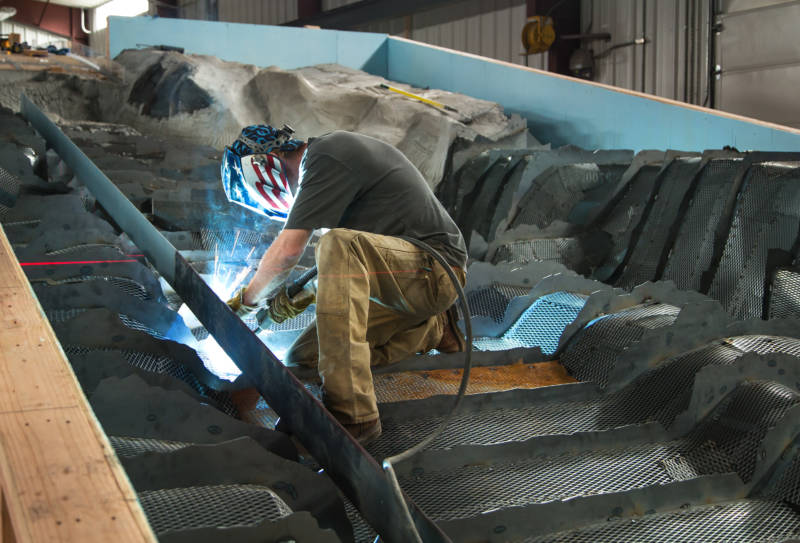BY JUSTIN FEIT –
Optimize your watering practices by addressing these areas
During the throes of summer, proper irrigation practices will preserve the look of your lawns and landscaping, but many facilities are wasting water with their irrigation systems, and the costs add up quickly. According to the EPA, “As much as 50% of this water is wasted due to overwatering caused by inefficiencies in irrigation methods and systems.” Make sure your irrigation is efficient with these four considerations.
1) Proper Maintenance and Oversight
Perhaps the most important mistake FMs are making with their irrigation systems is overlooking maintenance duties. They require careful oversight to ensure proper operation, and if that is neglected, it can lead to a massive waste of water.
“One of the things we see when we go out and look at systems that have been in a while is that they’re in really bad shape because nobody is really watching them and they’re not being maintained very well,” says Brian Vinchesi, President of Irrigation Consulting, Inc. in Pepperell, MA. “In order to save water, they need to be maintained on a regular basis by someone who knows something about irrigation.”
It isn’t uncommon for maintenance staffs to lack the proper expertise in irrigation systems. As systems break down over time, making ill-informed decisions during repair can have significant ramifications for the efficiency of your irrigation.
“For instance, a sprinkler breaks, but instead of putting in the same sprinkler they took out, they put in whatever they can find. That’s never good because it was hopefully all originally done to be consistent so it watered the same,” Vinchesi explains. “Every sprinkler waters differently. If you take out a sprinkler and put in something different, it’s going to water differently than the one you took out.”
Irrigation requires the facility staff’s regular attention via periodic checks. If an unbroken sprinkler system isn’t tuned for the right setting, it will waste a considerable amount of water. Vinchesi notes that sprinklers irrigating areas they shouldn’t be – like the pavement surrounding a median in a parking lot – can be one of the biggest culprits of water waste.
2) Overhead vs. Drip
The type of system you incorporate is important to the specific area that you hope to water. There are two main types of irrigation systems, each with its own set of advantages and disadvantages.
Drip systems provide a steadier flow of water that goes directly into the soil. When installed correctly, drip irrigation can reduce water use by 10-20% compared to a sprinkler system, according to Vinchesi. However, the problem with drip irrigation is that it requires meticulous maintenance.
“If you do not have a maintenance staff that is hands-on, you don’t want to do drip,” says Vinchesi. “Make sure it doesn’t have any breaks in it because it’s very susceptible to breaking. It requires a higher quality of water. It needs more infrastructure in terms of filters and regulators.”
Overhead systems are the more traditional sprinklers that spray water above the targeted plants. These systems require less maintenance for your facility staff, but they might not be as efficient with water usage.
Area and plant material are two of the most important factors to consider when deciding between overhead and drip systems. Overhead systems will be better for larger lawn spaces, for example, while smaller, more localized shrubs and flowers might be better with a drip system.
3) Irrigation Control and Scheduling
The schedule your irrigation is set at is vital to reducing water usage. Specifying your system’s operation over time has a major impact on conservation efforts.
“The biggest problem with irrigation is that people don’t change the schedule. If you’re in the north where you winterize, they turn it on in May and leave the same schedule on until October when they shut it off,” says Vinchesi. However, you do not need as much water during the May or October as you would in the middle of the summer. “Changing schedules is important so you reduce your water use and it treats the plant material better,” Vinchesi adds.
On a more micro level, it is common for irrigation systems to run on a set timer. While this is a simple and easily manageable schedule for landscape irrigation, it can lead to a lot of water waste.
Smart controllers that determine watering schedules are available in climate- or soil moisture-based versions. Vinchesi cites a typical water reduction of 25% for climate-based controllers and up to 40% for soil moisture-based controllers.
Yet smart controllers come with their own drawbacks. While the reduction in water waste is substantial, they require personnel to be on board with their operation. Because some maintenance staff members will better understand time-based systems, they often revert to that.
“The problem we have with smart controllers is that sometimes the maintenance staff doesn’t like them. You can have a site where you installed a smart controller and you go back in a few months and it’s been changed out for a conventional controller,” Vinchesi explains. “The smart controller is designed so that the maintenance staff doesn’t interact with it, and some people are very uncomfortable with that.”
Replacing a time-based controller with a smart controller depends in large part on the willingness of maintenance staff to adopt a new technology.
4) Landscaping
The final consideration for reducing irrigation water costs is focused on the spaces you are watering. Using the right plants and landscaping strategies can reduce costs substantially.
You have plenty of options to cut back on water usage by replacing plants. Landscaping specifically to require little irrigation can be achieved with xeriscaping, as native and drought-resistant plants will typically require little water outside of rain allowance.
You can also practice temporary irrigation with some plants. Vinchesi explains that in some climates, you can find plants that will only need irrigation for 3-5 years until they become well established into the new ecosystem.
In the case of one outdoor shopping mall in San Antonio, these approaches to landscaping have saved the facility 14 million gallons of water annually. The Village at Stone Oak, according to the EPA, has reduced its water use by 60%. By converting nearly 50,000 square feet of turf grass to xeriscape and modifying almost 85,000 square feet of its irrigation system, the facilities savings add up to $84,000 per year.
Irrigation can be an overly expensive process, but it doesn’t need to be. Addressing these areas can provide you with some relief from your utility bill.














 Passive house or Grandma’s house?/Public Domain
Passive house or Grandma’s house?/Public Domain


